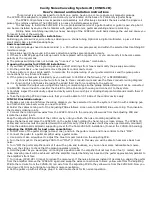
USER MANUAL
MI 406
Free Chlorine Meter
Dear Customer,
Thank you for choosing a Martini product.
This manual will provide you with the
necessary information for the correct use of
the instrument.
Please read it carefully before using the
meter. This instrument is in compliance with
directives.
SPECIFICATIONS:
Range
0.00 to 5.00 mg/L Cl
2
Resolution
0.01 mg/L (0.00-3.50 mg/L);
0.10 mg/L (above 3.50 mg/L)
Precision
±0.04 mg/L @ 1.50 mg/L
Light Source
Tungsten lamp
Light Detector
Silicon Photocell and
525 nm narrow band interference filter
Method
Adaption of the USEPA method 330.5 and Standard Method 4500-Cl G.
Environment
0 to 50°C (32 to 122°F);
100% RH max.
Battery Type
1 x 9 volt
Auto-Shut off
After 10' of non-use
Dimensions
192 x 104 x 52 mm
(7.5 x 4.1 x 2”)
Weight
380 g
MEASUREMENT PROCEDURE:
1• Turn the meter on by pressing
ON/OFF.
2• When the LCD displays “- - -”, the
meter is ready.
3• Fill the cuvet with 10
mL of sample, up to the
mark, and replace the
cap.
4• Place the cuvet into the
holder and ensure that
the notch on the cap is
positioned securely into
the groove.
5• Press ZERO and “SIP”
will blink on the display.
6• After a few seconds the
display will show “-0.0-
”. The meter is now
zeroed and ready for
measurement.
7• Remove the cuvet. Open it.
8• Add 3 drops of DPD 1 indicator and
3 drops of DPD 2 buffer to an empty
cuvet. Immediately add 10 mL of
unreacted sample. Replace the cap
and shake gently.
9• Replace the cuvet into the holder
and ensure that the notch on the cap
is positioned securely into the
groove.
10• Press READ and “SIP”
will blink
during
measurement.
11• The instrument directly
displays
the
concentration in mg/L of free
chlorine.
Interferences
• Positive error:
- Bromine
- Chlorine Dioxide
- Iodine
-
Oxidized Manganese and
Chromium
- Ozone
•
Alkalinity above 250 mg/L CaCO3 or
acidity above 150 mg/L CaCO3 will
not reliably develop the full amount
of color or it may rapidly fade.
To resolve this, neutralize the
sample with diluted HCl or NaOH.
• In case of water with hardness
greater than 500 mg/L CaCO3,
shake the sample for approximately
2’ after adding the powder reagent.





















